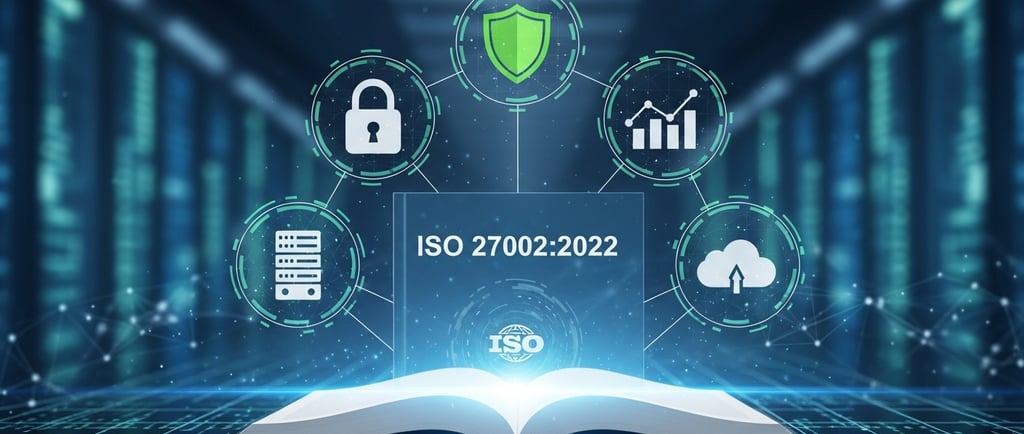Exploring the 11 New Controls in ISO 27002:2022


ISO/IEC 27002:2022 is not just an incremental update—it’s a significant overhaul aligning information security management with the realities of cloud adoption, modern cyber threats, and regulatory demands. Unlike prior versions, the revisions are grounded in lessons from actual data breaches, technology advances, and feedback from global implementation. Both the structure and substance have changed, with controls now reduced from 114 to 93, and grouped into four key domains: Organizational, People, Physical, and Technological. Eleven entirely new controls have been added, based on documented exposure points and real-world exploitation patterns.
The Four New Domains
The previous 14 control domains have been consolidated, reflecting how organizations actually secure information:
· Organizational Controls: Direction, structure, risk, supplier relations
· People Controls: Staff security, training, remote work
· Physical Controls: Premises, secure areas, monitoring
· Technological Controls: IT, development, networks, monitoring
For an official reference, see ISO’s publication summary and the standard’s Table of Contents.
Deep Dive Into the 11 New Controls
1. Threat Intelligence (5.7)
This control responds to the global rise in ransomware and APT tactics. It requires not just collecting but analyzing data on current threats—using government advisories, vendor feeds, and internal incident patterns. The primary aim is actionable intelligence that informs risk assessments and drives proactive change (see ISO Annex A and [Advisera breakdown]). The emphasis on sharing threat intel with suppliers aligns with NCSC, ENISA, and CISA recommendations.
2. Information Security for Use of Cloud Services (5.23)
Recognizing that cloud services are now the default platform for most organizations, ISO adds process rigor: cloud purchasing, onboarding, ongoing management, and offboarding must be evaluated for security impact. This control bridges to best practices published by CSA and ENISA’s cloud guidance.
3. ICT Readiness for Business Continuity (5.30)
Expanding from simple backups, this new control focuses on full ICT resilience—covering readiness planning, asset redundancy, incident simulation, and recovery testing. The COVID-19 pandemic’s disruptions and high-impact outages pushed this evolution. It aligns closely with the requirements of ISO 22301.
4. Physical Security Monitoring (7.4)
Modern attacks aren’t just digital—physical breaches (tailgating, hardware theft) remain core risks. ISO now mandates systematic monitoring of sensitive areas, using both surveillance technology and process checks. Integration with access control logs and incident reporting is recommended.
5. Configuration Management (8.9)
Misconfigurations are among the most exploited vulnerabilities worldwide. ISO now requires structured lifecycle management—baseline documentation, change management, automated monitoring, and strict audit trails. This shift echoes NIST’s CM guidance and OWASP security principles.
6. Information Deletion (8.10)
Responding to new data protection regulations (GDPR, CCPA), ISO now formalizes secure deletion of unneeded data. The standard references overwriting, degaussing, and physical destruction methods, with a focus on irreversibility and auditability. These practices are critical for avoiding privacy breach penalties.
7. Data Masking (8.11)
Data masking protects sensitive content in non-production environments. Techniques include pseudonymization, anonymization, and field-level obfuscation, tying into GDPR requirements and software development lifecycle risk reduction.
8. Data Leakage Prevention (8.12)
Here, the focus is both on technology (DLP tools, encryption, egress controls) and process (classification, policy enforcement, real-time monitoring). ISO emphasizes minimizing exposure risk, referencing industry practices from SANS and Gartner research.
9. Monitoring Activities (8.16)
Organizations must now formally implement continuous monitoring for anomalies and potential incidents—logging system, network, and user activities. ISO recommends automated tools, baselining, and threshold-driven alerts, referencing concepts from SOC/UEBA design.
10. Web Filtering (8.23)
Organizations must restrict access to malicious or inappropriate web resources. This covers technical enforcement (whitelisting/blacklisting, anti-malware integration) and policy-level education. The uptick in phishing and drive-by malware prompted this addition.
11. Secure Coding (8.28)
Secure software development now has its own mandated control—covering code review, input validation, secure error handling, anti-SQL injection practices, and secure dependency management. ISO aligns this with OWASP Top 10 and NIST SP800-53 recommendations.
How the Standard is Used in Practice
ISO/IEC 27002:2022 draws heavily from documented breaches and regulatory actions. For each new control, guidance includes not only what to implement but why—reflecting a broader shift from mere compliance to organizational resilience. The controls map directly to requirements from international bodies (ENISA, CSA, NIST) and are referenced in certification audits worldwide. Organizations are expected to tailor their controls based on risk assessments, asset profiles, and business strategy.
Key References:
· [ISO/IEC 27002:2022 official standard]
Final Note: Why This Matters
As cyber threats and compliance demands grow, the changes in ISO 27002:2022 enable organizations to focus resources where actual risk is highest. The new controls reflect international consensus, not just ISO’s internal committee, and are cited throughout industry research and audit findings. Adopting them is not about box-ticking—it’s about resilient, adaptive security in a volatile world.
